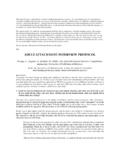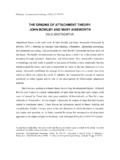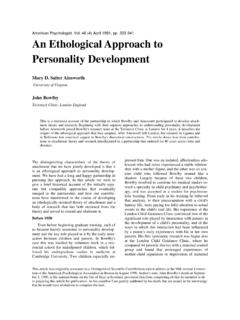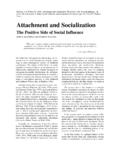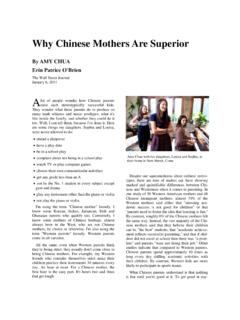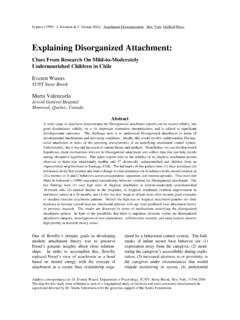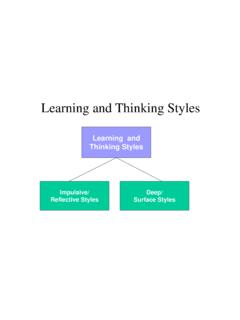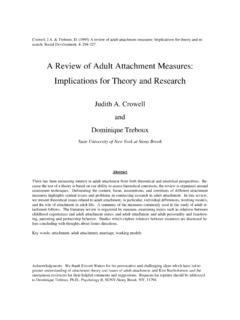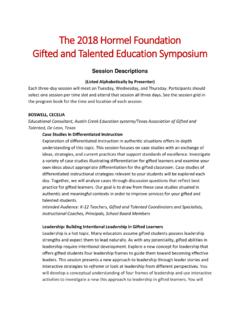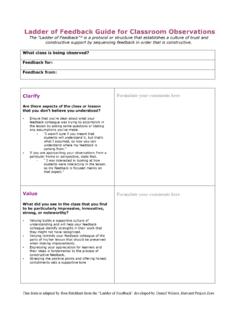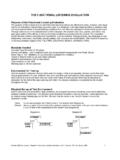Transcription of The Ainsworth Strange Situation - Stony Brook
1 2012 E. WatersThe Ainsworth Strange Situation This PowerPoint set consists of 132 slides illustrating the Ainsworth Strange Situation Procedure. It was designed for use in lecture courses, where students often find it difficult to see and follow key behaviors in real time. Using slides allows the instructor to pause and resume more easily than is often the case with tape or digital presentation includes brief statements of key concepts from Bowlby- Ainsworth attachment theory. There are also references to a few key empir-ical studies. This information is provided as context for classroom present-ations. Published work should refer to full length articles, not to this . is copyrighted material. Copyright will be enforced. Users may adapt these contents for classroom use by deleting selected slides.
2 Do not incorporate all or parts of this material (including photographs) for distribution, publication, or use in any medium (including internet) without the author s written permission. 2012 E. WatersThe Ainsworth Strange Situation This behavior occurs across time and across contexts. As such, it is difficult and time-consuming to assess in homes and unconstrained outdoor settings. The Strange Situation is a semi-structured laboratory procedure that allows us to identify, without lengthy home observation, infants who effectively use a primary caregiver as a secure hallmark of infant attachment is using one or a few people as a secure base from which to explore and as ahaven of safety when Ainsworth 2012 E. WatersThe Ainsworth Strange Situation The Strange Situation is not a test of whether the infantis attached to the adult.
3 The procedure is conducted withsomeone who is assumed to be an attachment question is not whether the baby is attached or not attached to the adult. We assume that all normalhome reared 12-18 month-olds are attached to their Strange Situation is designed to tell us somethingabout the quality of the relationship. 2012 E. WatersThe Ainsworth Strange Situation Specifically, is the infant able to use the person it is attached to as a secure base from which to exploreand as a haven of safety and comfort?Or, is the infant lacking confidence in the caregiver'savailability and responsiveness and thus unable touse the caregiver effectively? Ainsworth , Blehar, Waters & Wall (1977) and Vaughn& Waters (1990) validated the Strange Situation as anindication of how smoothly and effectively an infantuses a particular caregiver as a secure base at home.
4 2012 E. WatersStrange Situation Procedure The Strange Situation is conducted in a room with: A one-way window for observing and filming A door for adults to enter and leave A collection of toys for the infant to explore A chair for mother to sit in A chair for a research assistant to sit in 2012 E. WatersStrange Situation Procedure TOYTOYTOYTOYTOYMom chairAssistantchairDoorOne-way window 2012 E. WatersStrange Situation Procedure The procedure consists of 8 brief episodes:Ep. 1-Mother and baby are introduced intothe room. (1 minute)Ep. 2- Mother sits and baby plays freely for3 minutes. Mother is responsive ifbaby initiates play or interaction. 2012 E. WatersStrange Situation Procedure Ep. 3-Female research assistant enters,sits quietly for 1 minute, talks tomother for 1 minute, and then sitson floor and engages baby for 1 research assistant (often called "the stranger") is not there to scare the baby.
5 She is there as a companion so the baby will not be entirely alone when mother leaves. 2012 E. WatersStrange Situation Procedure Ep. 4- Mother says "bye bye" and leavesthe room for 3 minutes. Once out of the room, mother joins the researchers at the one-waywindow. 25% of babies cry. Mother can stopthe procedure if the baby seems the baby cries or not tells us very little about attachment quality. 2012 E. WatersStrange Situation Procedure Ep. 5- Mother returns. (Stranger leaves quietly.)Mother pauses just inside the door. Holds out her hands toward babyand says pleasantly, "I'm back".If baby wants to be picked up,mother does necessary, mother comforts tries to get baby back to in reunion episodes is the most usefulindicator of attachment quality.
6 2012 E. WatersStrange Situation Procedure Ep. 6- Stranger has already leaves for 3 is watches from behind one-way is the most stressful episode. If infant cries continuously for 1 minute, mother returns early. 2012 E. WatersStrange Situation Procedure Ep. 7- Stranger returns for a 3 minute picks the baby up if necessary to comfort tries to interest baby in the baby won't be comforted, strangersits and waits for mother to return. This episode is primarily used to show that babies are not merely averse to being alone - they want mom. 2012 E. WatersStrange Situation Procedure Ep. 8- Mother returns. (Stranger leaves quietly.)Mother pauses just inside the door. Holds out her hands toward babyand says pleasantly, "I'm back".
7 If baby wants to be picked up,mother does necessary, mother comforts in the two reunion episodes (Ep. 5 & Ep. 8) is the key to evaluating attachment security. 2012 E. WatersStrange Situation ClassificationsSecure65-75% of middle-class, home-reared, 1-year-oldsConfident in caregiver s availability & secure base use at Situation Behavior: May or may not mother's angry avoidance or uncomfortable to play when comforted. 2012 E. WatersStrange Situation ClassificationsInsecure - Avoidant10-15% of middle-class, home-reared, 1-year-oldsLacks confidence that caregiver is available & responsive. Inconsistent secure base use at Situation Behavior: Less likely to cry - esp. 1st ignore mother's approach and then stop or turn continue play without acknowledging heart-rate.
8 2012 E. WatersStrange Situation ClassificationsInsecure - Disorganized<5% of middle-class, home-reared, 1-year-olds Potentially as many as 50-75% of high risk 1-year-olds. Interpretation of this classification is still under study. It may be that a motivational system other than attachment is driving the infant s responses. Strongly associated with significant outcomes some of which may reflect risk status rather than insecure attachhment per Situation Behavior: A wide range of odd , out of context behaviors not seen in other groups. Some are fleeting followed by ordinary attachment behavior. Sometimes key is mixing signs of A and C criteria across episodes. 2012 E. WatersStrange Situation ClassificationsInsecure - Resistant15-20% of middle-class, home-reared, 1-year-oldsLacks confidence that caregiver is available & responsive.
9 Inconsistent secure base use at Situation Behavior: Hard crying during both or absent approach when mother cry to be held and then struggle to be put slapping at toys offered May not return to good quality play. 2012 E. WatersPatterns of Attachment In TheStrange Situation Secure Insecure Avoidant Insecure ResistantDisorganized 2012 E. WatersGroup BSecure 2012 E. WatersMother leaves. 2012 E. WatersBaby crawls to door. 2012 E. WatersBaby at door - crying. 2012 E. WatersWon t accept comfort from Stranger. Stranger 2012 E. WatersMom returns. Baby steps toward her. 2012 E. WatersBaby looks up at Mom. 2012 E. WatersBaby reaches to be picked up. 2012 E. WatersHeld by Mom. Arms around; legs around; head down. 2012 E.
10 WatersLeft arm wrapped around; hand down. 2012 E. WatersRemains in contact. 2012 E. WatersMore contact; head down; crying stopped. 2012 E. WatersMom sits; Baby maintains close contact. 2012 E. WatersRelaxes a bit. Stays on lap; interacts with Mom. 2012 E. WatersInitiates familiar play (Greek Dance). 2012 E. WatersInterest in environment recovers. Points to bird mobile. 2012 E. WatersLooks for Mom s reaction. 2012 E. WatersMore interaction with Mom. How big are you? game. 2012 E. WatersHow big are you?, again. 2012 E. WatersSooo big!. Mom-baby face-to-face. 2012 E. WatersAffectionate contact. Fully recovered from then went off Mom s lap to play with toys. 2012 E. WatersGroup AAvoidant 2012 E. WatersFirst separation.
